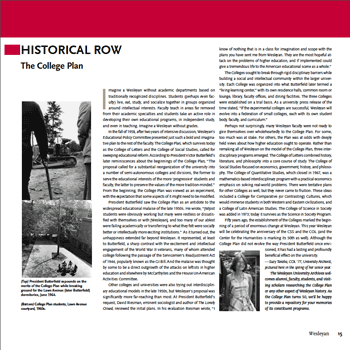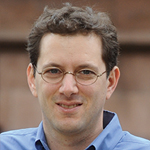HISTORICAL ROW: THE COLLEGE PLAN
 Imagine a Wesleyan without academic departments based on traditionally recognized disciplines. Students (perhaps even faculty) live, eat, study, and socialize together in groups organized around intellectual interests. Faculty teach in areas far removed from their academic specialties and students take an active role in developing their own educational programs, in independent study, and even in teaching. Imagine a Wesleyan without grades.
Imagine a Wesleyan without academic departments based on traditionally recognized disciplines. Students (perhaps even faculty) live, eat, study, and socialize together in groups organized around intellectual interests. Faculty teach in areas far removed from their academic specialties and students take an active role in developing their own educational programs, in independent study, and even in teaching. Imagine a Wesleyan without grades.
In the fall of 1958, after two years of intensive discussion, Wesleyan’s Educational Policy Committee presented just such a bold and imaginative plan to the rest of the faculty. The College Plan, which survives today as the College of Letters and the College of Social Studies, called for sweeping educational reform. According to President Victor Butterfield’s later reminiscences about the beginnings of the College Plan, “The proposal called for a substantial reorganization of the university into a number of semi–autonomous colleges and divisions, the former to serve the educational interests of the more ‘progressive’ students and faculty, the latter to preserve the values of the more tradition–minded.” From the beginning, the College Plan was viewed as an experiment, with the expectation that some aspects of it might need to be modified.
President Butterfield saw the College Plan as an antidote to the widespread educational malaise of the late 1950s. He wrote, “[M]ost students were obviously working but many were restless or dissatisfied with themselves or with [Wesleyan], and too many of our ablest were failing academically or transferring to what they felt were socially better or intellectually more exciting institutions.” As it turned out, the unhappiness extended far beyond Wesleyan. It represented, at least to Butterfield, a sharp contrast with the excitement and intellectual engagement of the World War II veterans, many of whom attended college following the passage of the Servicemen’s Readjustment Act of 1944, popularly known as the GI Bill. And the malaise was thought by some to be a direct outgrowth of the attacks on leftists in higher education and elsewhere by McCarthyites and the House Un–American Activities Committee.
Other colleges and universities were also trying out interdisciplinary educational models in the late 1950s, but Wesleyan’s proposal was significantly more far–reaching than most. At President Butterfield’s request, David Riesman, eminent sociologist and author of The Lonely Crowd, reviewed the initial plans. In his evaluation Riesman wrote, “I know of nothing that is in a class for imagination and scope with the plans you have sent me from Wesleyan. They are the most hopeful attack on the problems of higher education, and if implemented could give a tremendous life to the American educational scene as a whole.”
The Colleges sought to break through rigid disciplinary barriers while building a social and intellectual community within the larger university. Each College was organized into what Butterfield later termed a “living–learning center,” with its own residence halls, common room or lounge, library, faculty offices, and dining facilities. The three Colleges were established on a trial basis. As a university press release of the time stated, “If the experimental colleges are successful, Wesleyan will evolve into a federation of small colleges, each with its own student body, faculty, and curriculum.”
Perhaps not surprisingly, many Wesleyan faculty were not ready to give themselves over wholeheartedly to the College Plan. For some, too much was at stake. For others, the Plan was at odds with deeply held views about how higher education ought to operate. Rather than remaking all of Wesleyan on the model of the College Plan, three interdisciplinary programs emerged. The College of Letters combined history, literature, and philosophy into a core course of study. The College of Social Studies focused on economics, government, history, and philosophy. The College of Quantitative Studies, which closed in 1967, was a mathematics–based interdisciplinary program with a practical economics emphasis on solving real–world problems. There were tentative plans for other Colleges as well, but they never came to fruition. These ideas included a College for Comparative (or Contrasting) Cultures, which would immerse students in both Western and Eastern civilizations, and a College of Latin American Studies. The College of Science in Society was added in 1973; today it survives as the Science in Society Program.
Fifty years ago, the establishment of the Colleges marked the beginning of a period of enormous change at Wesleyan. This year Wesleyan will be celebrating the anniversary of the CSS and the COL (and the Center for the Humanities is marking its 50th as well). Although the College Plan did not evolve the way President Butterfield once envisioned, it has had a lasting and profoundly beneficial effect on the university.
—Suzy Taraba, COL ’77, University Archivist, pictured here in the spring of her senior year.
The Wesleyan University Archives welcomes alumni, faculty, students, and visiting scholars researching the College Plan or any other aspect of Wesleyan history. As the College Plan turns 50, we’d be happy to provide a repository for your memories of its constituent programs.

